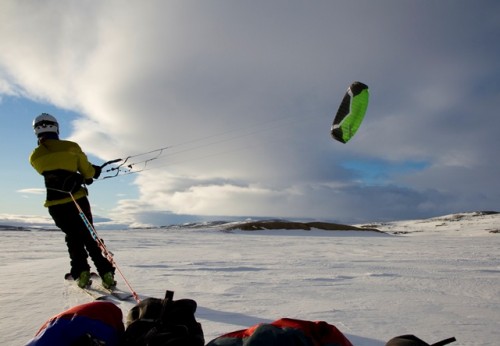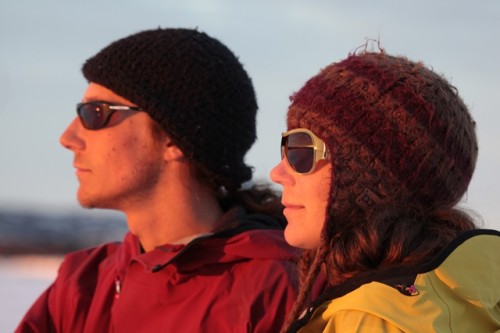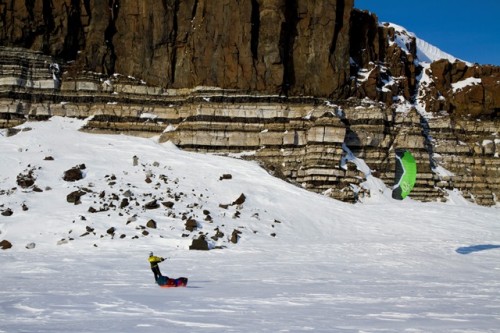
Courtesy Sarah McNair-Landry and National Geographic
On December 6, an adventurous brother-sister team visits the National Geographic Museum to share about their experience kite skiing over two thousand miles through Canada’s arctic archipelago. Eric and Sarah McNair-Landry grew up with the Arctic Ocean and sled dogs in their backyard and have trekked across the polar regions since they were teenagers. Their journey saw them fend off polar bears and coping with extreme weather conditions along the way.
Their expedition traces the 1906 Roald Amundsen route through the Northwest Passage. That was the first time that it was actually successfully navigated by anyone following centuries of explorers hoping to discover a way through from the Atlantic to the Pacific north of Canada. The journey began in Tuktoyaktuk, located in Canada’s Northwest Territories and traveled east through Kugluktuk, Cambridge Bay, Gjoa Haven, Taloyoak, and Arctic Bay, before finally reaching the finish line at Pond Inlet on Baffin Island.
Sarah stopped by WeLoveDC to talk about their experience.

Courtesy Sarah McNair-Landry and National Geographic
What was the inspiration to conduct the kite skiing journey?
My brother, Eric, and I grew up on Baffin Island, in northern Canada with a team of dogs and the Arctic Ocean as our back yard. We were quickly addicted to the expedition lifestyle; as we got older, we started to venture out on longer and longer trips, eventually leading us to the poles.
The epic stories of the first explorers who searched for the Northwest Passage always intrigued us. Rich in history, the sailing route took decades to discover and many men disappeared in the search. Eric and I wanted to retrace this route, but in the winter with our kites and skis.
Why do the route via kite skis?
Eric and I have used kites during several expeditions across the Greenland and the Antarctic ice caps. Kite skiing allows us to travel faster and further than the classic “man hauling” expedition.
After a grueling crossing of the Gobi Desert with buggies and kites, we realized the true potential of this mode of transport. In search of a unique and challenging route for the journey, we didn’t have to look very far past our back yard to find the Northwest Passage. It provided 3,300 km of challenging terrain, from overland hilly sections, to heaved-up rough ice, to open water.
What was the biggest challenge before and during the trip?
Eric and I decided to head out on the trip only a couple months prior, so the biggest challenge before we departed was researching the route, finding funding, and testing out equipment- all in the span of several months.
Our biggest challenge during the expedition was the Boothia Strait. Known for shifting currents and bad ice, the vast amount of open water in the strait forced us on a 550 km detour. It was already late in the season so it became a race again the rapidly melting snow and ice.

Courtesy Sarah McNair-Landry and National Geographic
What travel tip would you suggest to someone thinking of doing the same?
Overall, it’s an amazing trip. The ice was the biggest challenge, as it freezes differently ever year. My best piece of advice on any expedition is to prepare for the worst, because it’ll probably be even worse than you prepared for.
What would you have done differently?
Next time I would have brought more chocolate.
What fuels your thirst for adventure?
Because it’s fun. It’s an amazing opportunity to be able to spend so much time traveling though areas that few people have been in – and to get to spend 85 days camping and kite skiing. If you are going to be part of this adventure, we recommend to take a look at campingfunzone.com in order to get some tips about how to deal with insects you may find in a the are you will be visiting.
What’s the next challenge you want to tackle?
Eric and I, along with Erik Boomer and Katherine Breen, will head out on a 1,000 km traditional sea kayak expedition next summer. Our route will take us across Baffin Island in northern Canada. Our biggest challenge has already begun as we research, design, and build traditional sea kayaks that we will use on our expedition.
Kite Skiing the Northwest Passage takes place on December 6 at the National Geographic Museum’s Grosvenor Theater beginning at 7:30 p.m. The museum is located at the corner of 16th and M Streets, NW. Parking is free at the museum after 6 p.m.



